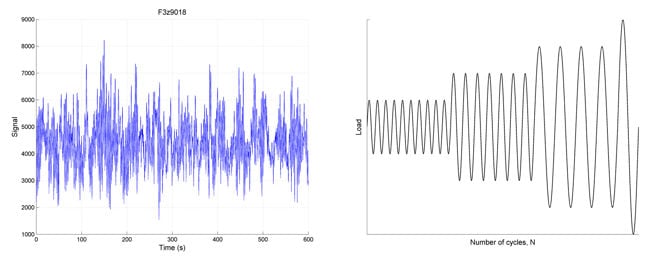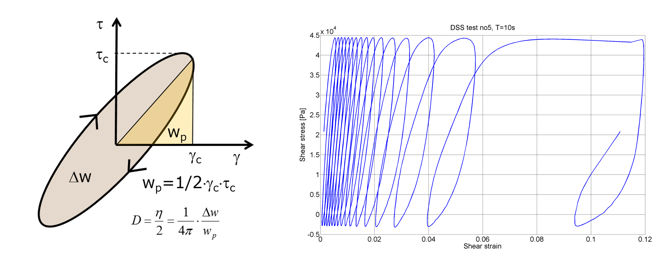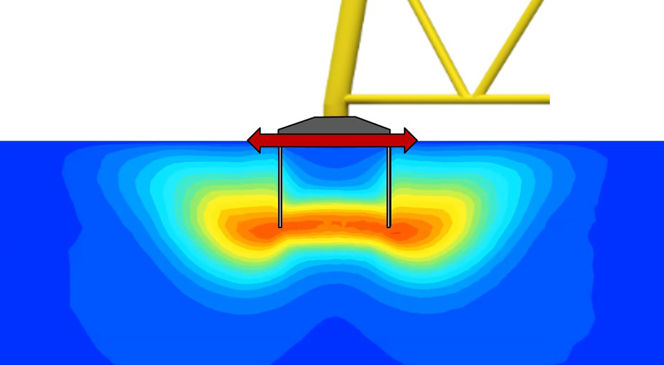- NGI /
- Projects /
- Offshore wind turbine foundations /
- Geotechnical design
Geotechnical design

Cyclic/dynamic load histories
The aim was to develop a well verified, robust, reliable and efficient procedure for counting number of cycles in a random / irregular load time history, like from waves, earth-quakes or vibrations. The counting method should be optimized for rating the degrading effect of the load on soils and soil Foundations.
A new method has been developed that can transfer general, often highly irregular wave and wind load data, to standard input format for soil cyclic degradation calculations. This transformation is to a single frequency load with separation of average and cyclic components and counting & grouping of loads into parcels of increasing amplitude and mean value.

Converting load time series to standard input format for soil cyclic degradation calculations
Rain flow counting is often used in fatigue analysis of structures. In the rain flow method, all peaks are identified and counted. However, the method allows amplitudes to be determined from local maxima and minima belonging to different cycles, which may lead to overestimation of amplitudes. As soil experiences kinematic and not isotropic hardening, the rain flow method is probably not so well suited for soil analysis.
In the new method, the amplitude of each half cycle is determined from adjacent local maxima and minima. The drawback is that the method requires operator input and is therefore more sensitive to operator judgement. The signal can either be counted as one cycle with a high amplitude disregarding the smaller internal cycles, or it could be counted as many cycles with lower amplitudes. The new method gives the operator the ability to override the maxima and minima identified by the program and define cycles interactively on the screen.
In order to evaluate the effect of different ways to define cycles on soil shear strain accumulation, the method uses NGI’s in-house program ACCUMUL to calculate resulting equivalent number of cycles for different cycle definitions.
The new method has been tested on a simulated load time series and the result compared with that obtained from a rain flow analysis on the same load time series. The comparison shows that the deviations between the two methods are considerable, in terms of both the identified number of cycles in the time series and the calculated equivalent number of cycles. Correct definition of load cycles is very important for design of the structure and foundation.
Nonlinear stiffness and damping
The aim was to develop methodologies for estimating soil damping from laboratory tests, and to dissiminate this new methodology in reports and one publication. This work task should also provide a rough assessment of the importance of the soil damping on the Offshore Wind Turbine (OWT) response under certain design load conditions. Due to the low load frequencies in question, emphasis has been on the intrinsic soil damping rather than on radiation effects.
The periodic forces from wind, surface waves and swells acting on offshore installations, such as OWTs, lead to cyclic motion of the foundation soils. The damping characteristics of the soil results in energy dissipation, which in turn alters the cyclic response of the structure.
Understanding damping is therefore important for the cost-effective design of structures. OWT foundation damping has not been widely studied, and consequently the influence of soil damping on OWT structural response is poorly understood.
Research undertaken by NGI provides a step forward towards a better understanding and improved interpretation of stiffness and damping parameters for soils and foundations.
Intrinsic soil damping under combined permanent and cyclic load
OWT foundations are typically subject to combinations of cyclic and average loads from wind and waves. In addition, the different loads may have different frequencies and approach from different directions.
Hysteretic soil damping enters only through the cyclic part of the stress-strain curve during a load cycle, but often an average load is also present, leading to strain accumulation. The figure below shows a typical cyclic stress-strain curve, as well as an example laboratory measurement including both cyclic and average stresses.

A new method for deriving soil damping from the laboratory
A new method for quantifying soil damping from laboratory tests has been developed. Analyses of laboratory data have shown that the interpreted hysteretic soil damping has historically been overestimated for large accumulated strains. This is visualized in Figure 2, where damping as a function of cyclic strain level are compared for the new and old interpretation methods.
Effect of the foundation nonlinearity on monopile Offshore Wind Turbines
OWTs are lightly damped structures, often with fatigue governing the design. Therefore, a thorough understanding of different damping sources, such as aerodynamic, hydrodynamic, structural, and foundation is essential for a cost effective design. Foundation damping is recently attaining more interest from the OWT industry. Foundation stiffness and damping depends not only on the soil properties but also foundation geometry, load intensity and frequency.
Soil models accounting for cyclic degradation
The task was to upgrade the material soil models PDCAM and UDCAM for the newest versions of the finite element program PLAXIS, Plaxis 2000 and Plaxis 3D. The mail aim is to make the soil models more robust and stable. This includes more comprehensive requirements to the parameters of the input data and automatic evaluation of input data.
Cyclic degradation is reduction in strength and stiffness of the soil due to the generation of pore pressures under undrained and partly drained conditions and destructuration during cyclic loading.

Bucket foundation modelled using PDCAM
Offshore structures are subjected to combined static and cyclic loading due to the weight of the structure, wind, current and waves. The effect of cyclic degradation in the soil during these load conditions may be significant and therefore needs to be properly taken in to consideration.
How do we account for cyclic degradation?
We analyse the behavior of the soil under cyclic loading based on non-linear stress-strain relationships from cyclic contour diagrams. These contour diagrams are established from laboratory tests, and they contain information about the reduced strength, the increased cyclic strain amplitudes and increased permanent strains as function of number of cycles at different cyclic and average shear stress levels.

Hans Petter Jostad
Technical Director Computational geomechanics hans.petter.jostad@ngi.no+47 992 61 171